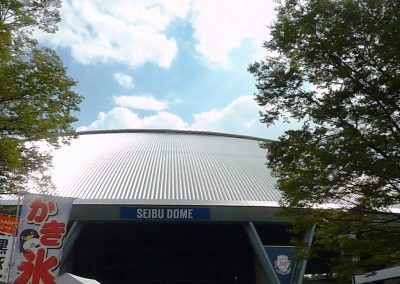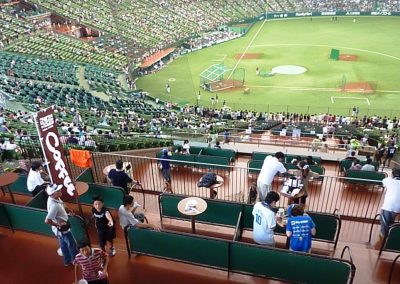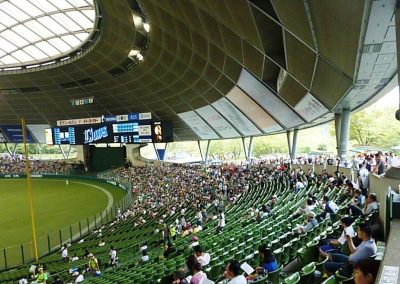Belluna Dome - Seibu Lions
- Sean MacDonald
- May 11, 2013
- 5 min read
Photos by Sean MacDonald, Stadium Journey
Stadium Info FANFARE Score: 2.26
Belluna Dome 2135 Kami-Yamaguchi Tokorozawa-City, Saitama 359-1153 Japan
Year Opened: 1979 Capacity: 35,655
When is a Dome not a Dome
NOTE: The name of the stadium has changed since this review was written.
In 1979, the Seibu Lions moved to Tokorozawa, a city in Saitama Prefecture, just north of Tokyo. A new stadium was built for them and called Seibu Lions Stadium in a testament to originality. It was a typically pedestrian ballpark until 1997, when a roof was installed over a two year period and the stadium was renamed Seibu Dome, yet again a brilliant and unexpected decision.
In 2009, the Lions took the $51.1 million posting fee they earned from Boston in the Daisuke Matsuzaka deal and renovated the dome with new concession stands, seating, a scoreboard and even toilets. Still, the overall feeling here is one of mediocrity, which is a shame as the Lions are the Pacific League’s most successful team, winning 13 out of 17 pennants between 1982 and 1998, and taking 8 Japanese titles in that time. Most recently the team won the 2008 Asian championship.
There is no wall behind the stands, so it is not a true dome, and the elements are still part of the experience: not good in Japan’s hot and humid summer. The stadium is built into the side of a hill which requires you to walk up a fairly steep incline to get to the infield seats. On a 35 degree day, you will be sweating by the time you reach your seat, so bring a face towel to dry yourself and then grab a beer and enjoy the game.
Food & Beverage 2
The stadium offers almost nothing intriguing once you are inside, but fortunately there are a number of concession stands outside. If you get there an hour or two before the game, take the time to wander around the area in front of the stadium and examine the various options. I tried a meat-covered onigiri (rice ball) for 400 yen which was OK. There are plenty of other choices though, and you can bring whatever you buy here into the stadium. KFC is the most famous name you will see, but I would suggest trying one of the other lesser-known stands, such as the kebab truck or creperie.
Inside the park, there are dozens of small stands that dot the incline, but they mostly offer typical ballpark fare. There is a large three-level restaurant/team store called L’s that offers tables at which you can stand, but again the offerings are unappealing. Still, it might be worth stopping here as this area offers good views of the game, lying between home and first base.
Drinks are served by the countless beer girls who spend the game running around with large kegs on their back, from which they dispense draft beer. Other vendors have different libations if beer is not your thing, just flag one down and you will be served with a smile.
Atmosphere 2
The stadium has little in the way of a ballpark feel; the lack of a wall allows a lot of ambient noise to escape and the way the stadium is built into the hill makes the seats seem farther from the field. The best sections directly behind home plate are reserved for season seat holders and are filled with pairs of large chairs, which further reduces the feeling of being at a ballgame.
The field is entirely ugly green turf except around the bases, the seats are an ugly uniform green, the fence another ugly green and even the outfield berm is really just concrete covered with yet a different ugly shade of green. Seibu Dome is not a pleasant sensory experience.
There is a very large scoreboard but it is not used as well as it could be. The lineups are displayed next to a giant linescore, but they could do with more replays.
Domes are generally lacking in a true baseball atmosphere and the Seibu Dome is no different. It is a decent ballpark but that is about it.
Neighborhood 1
The stadium is in the middle of nowhere, taking over an hour to reach from Shinjuku. There is nothing in the immediate vicinity and there is no reason to explore before or after the game. The only thing nearby is an amusement park one train stop away and also run by Seibu. If you are with a family, this might be worth visiting before a night game.
Fans 3
The Seibu fans are OK, cheering their team at the right time and waving towels when a run scores. But compared to the other fan groups in Japan, the Lions’ supporters are average, with little to separate them from a typical fan base.
Access 3
The stadium is right next to Seibu Kyujo Mae train station, which is over an hour from Tokyo. There are many different ways to get here, the easiest being a direct train from Ikebukuro station on the Seibu Ikebukuro line.
You enter the stadium behind the batters eye and move to the first or third base side depending on your seats. Lions’ fans sit on the third base side, a rarity in Japan, where the home team supporters sit on the first base side. If you are in the outfield cheering section, you will reach your seat almost immediately, but if you have reserved seats, you will make your way up the hill, passing through two more checkpoints where you need to show your ticket again.
It is easy to move around the stadium and you can watch the game from the incline without being asked to move. This is helpful during a hot day as the hill is often blessed with a breeze that doesn’t reach the seats below.
You cannot make your way between the first and third base sides – the area behind home plate is guarded as it houses the season ticket seats and the common man is not allowed in. As the stadium is perfectly symmetrical, that’s not much of an issue, although the concession stands might be slightly different from one side to the other.
Return on Investment 3
The best thing about Seibu Dome is that tickets are reasonably priced and there are many options. The best are the field view seats, which are right on the field behind first and third base and go for 4,800 yen ($60) on game day. There are also the Bench Side seats, next to the dugout and close to home plate which are also 4,800 yen. These are often sold out, but there are always A and B reserved seats (3,500 and 3,000 yen respectively) available. Tickets are cheaper before game day and if you are a fan club member, even better discounts are to be had, but these are difficult for people visiting for a short time.
I highly recommend that you avoid the outfield area – the views are not good from there as it is quite low, and after 3 hours sitting on the ground, you will be in pain.
.
Extras 2
The Lions’ minor league stadium is located next door and if you are extremely fortunate you might get a day-night doubleheader, so be sure to check the farm team’s schedule at the NPB home page.
The Lions offer fans of different types a chance to experience being on the field. For example, Tuesday nights are catch-ball nights, where any fan can play catch on the field after the game, while Wednesday evening is ladies night, where women can try pitching or experience sitting in the Lions’ dugout among other activities.
Final Thoughts
Given the distance from Tokyo and the lack of anything particularly compelling here, a visit to Seibu Dome is not something that most baseball fans need put on their bucket list. If you want to see all 12 ballparks in the country, this is the one which will probably be the most annoying to get to and offer the least memorable experience.










Comments